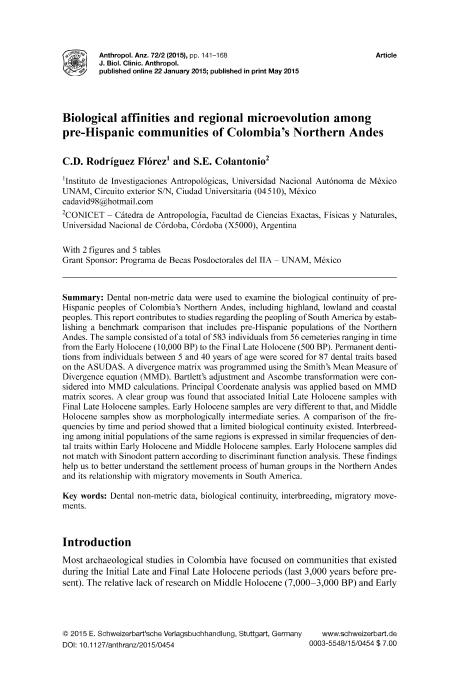Mostrar el registro sencillo del ítem
dc.contributor.author
Rodriguez Florez, Carlos David

dc.contributor.author
Colantonio, Sonia Edith

dc.date.available
2018-11-02T20:40:15Z
dc.date.issued
2015-05
dc.identifier.citation
Rodriguez Florez, Carlos David; Colantonio, Sonia Edith; Biological affinities and regional microevolution among pre-Hispanic communities of Colombia's Northern Andes; E. Schweizerbart'sche Verlagsbuchhandlung; Anthropologischer Anzeiger; 72; 2; 5-2015; 141-168
dc.identifier.issn
0003-5548
dc.identifier.uri
http://hdl.handle.net/11336/63565
dc.description.abstract
Dental non-metric data were used to examine the biological continuity of pre- Hispanic peoples of Colombia's Northern Andes, including highland, lowland and coastal peoples. This report contributes to studies regarding the peopling of South America by establishing a benchmark comparison that includes pre-Hispanic populations of the Northern Andes. The sample consisted of a total of 583 individuals from 56 cemeteries ranging in time from the Early Holocene (10,000 BP) to the Final Late Holocene (500 BP). Permanent dentitions from individuals between 5 and 40 years of age were scored for 87 dental traits based on the ASUDAS. A divergence matrix was programmed using the Smith's Mean Measure of Divergence equation (MMD). Bartlett's adjustment and Ascombe transformation were considered into MMD calculations. Principal Coordenate analysis was applied based on MMD matrix scores. A clear group was found that associated Initial Late Holocene samples with Final Late Holocene samples. Early Holocene samples are very different to that, and Middle Holocene samples show as morphologically intermediate series. A comparison of the frequencies by time and period showed that a limited biological continuity existed. Interbreeding among initial populations of the same regions is expressed in similar frequencies of dental traits within Early Holocene and Middle Holocene samples. Early Holocene samples did not match with Sinodont pattern according to discriminant function analysis. These findings help us to better understand the settlement process of human groups in the Northern Andes and its relationship with migratory movements in South America.
dc.format
application/pdf
dc.language.iso
eng
dc.publisher
E. Schweizerbart'sche Verlagsbuchhandlung
dc.rights
info:eu-repo/semantics/openAccess
dc.rights.uri
https://creativecommons.org/licenses/by-nc-sa/2.5/ar/
dc.subject
Biological Continuity
dc.subject
Dental Non-Metric Data
dc.subject
Interbreeding
dc.subject
Migratory Movements
dc.subject.classification
Antropología, Etnología

dc.subject.classification
Sociología

dc.subject.classification
CIENCIAS SOCIALES

dc.title
Biological affinities and regional microevolution among pre-Hispanic communities of Colombia's Northern Andes
dc.type
info:eu-repo/semantics/article
dc.type
info:ar-repo/semantics/artículo
dc.type
info:eu-repo/semantics/publishedVersion
dc.date.updated
2018-09-24T14:29:54Z
dc.identifier.eissn
2363-7099
dc.journal.volume
72
dc.journal.number
2
dc.journal.pagination
141-168
dc.journal.pais
Alemania

dc.description.fil
Fil: Rodriguez Florez, Carlos David. Universidad Nacional Autónoma de México; México
dc.description.fil
Fil: Colantonio, Sonia Edith. Universidad Nacional de Córdoba. Facultad de Ciencias Exactas, Físicas y Naturales; Argentina. Consejo Nacional de Investigaciones Científicas y Técnicas. Centro Científico Tecnológico Conicet - Córdoba. Centro de Investigaciones y Estudios sobre Cultura y Sociedad. Universidad Nacional de Córdoba. Centro de Investigaciones y Estudios sobre Cultura y Sociedad; Argentina
dc.journal.title
Anthropologischer Anzeiger
dc.relation.alternativeid
info:eu-repo/semantics/altIdentifier/url/https://www.ingentaconnect.com/content/schweiz/aa/2015/00000072/00000002/art00002
dc.relation.alternativeid
info:eu-repo/semantics/altIdentifier/doi/http://dx.doi.org/10.1127/anthranz/2015/0454
Archivos asociados
